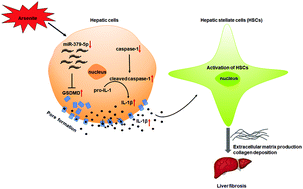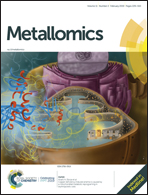Regulation of gasdermin D by miR-379-5p is involved in arsenite-induced activation of hepatic stellate cells and in fibrosis via secretion of IL-1β from human hepatic cells
Abstract
Arsenic is an environmental toxicant and human carcinogen. The liver is the main site of arsenic storage and metabolism. Exposure to excessive arsenic causes liver damage and release of pro-inflammatory factors, which in turn lead to liver fibrosis. Gasdermin D (GSDMD), a mediator of pyroptosis, has low expression in hepatic tumor cells. In L-02 cells, arsenite caused increases of GSDMD and cleaved caspase-1 levels and decreases of caspase-1 and miR-379-5p levels. It also promoted the release of IL-1β in a concentration- and time-dependent manner. Luciferase reporter assays showed that GSDMD was a direct target of miR-379-5p. In L-02 cells, the over-expression of miR-379-5p blocked the arsenite-induced increases of GSDMD levels and the release of IL-1β, effects that were reversed by up-regulation of GSDMD. LX-2 cells, cultured in the media from arsenite-treated L-02 cells, showed elevated levels of proliferating cell nuclear antigen (PCNA), collagen I, vimentin, and α-smooth muscle actin (α-SMA), which indicated activation of these cells. Activation of LX-2 cells by media from arsenite-treated L-02 cells was inhibited by IL-1β neutralizing antibody. The media from arsenite-treated L-02 cells transfected with an miR-379-5p mimic inhibited the activation of LX-2 cells, a process that was reversed by up-regulation of GSDMD and by co-treatment with human recombinant IL-1β. Chronic exposure to arsenite induced, in liver tissue of mice, morphological damage, collagen deposition, and activation of hepatic stellate cells (HSCs). In liver tissue of arsenite-exposed mice, the levels of miR-379-5p were lower, but the levels of GSDMD and cleaved caspase-1 were elevated, and in sera from arsenite-exposed mice, the IL-1β levels were elevated. These results indicate that, by elevating the secretion of IL-1β, miR-379-5p regulation of GSDMD is involved in arsenite-induced activation of HSCs and in hepatic fibrosis. This establishes a previously unknown molecular mechanism for arsenite-induced liver damage, inflammation, and fibrosis.



 Please wait while we load your content...
Please wait while we load your content...